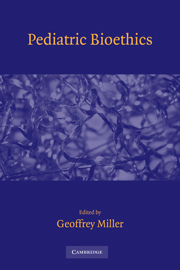Book contents
- Frontmatter
- Contents
- Contributors
- Preface
- A THE FOUNDATION: THEORY AND PRINCIPLES
- B GENETICS AND THE NEWBORN
- C THERAPIES
- 12 Rationality, Personhood, and Peter Singer on the Fate of Severely Impaired Infants
- 13 The Ethics of Controlling Reproduction in a Population with Mental Disabilities
- 14 Pediatric Innovative Surgery
- 15 Conjoined Twins
- 16 Ethics and Immunization
- 17 Psychotropic Drug Use in Children: The Case of Stimulants
- D END OF LIFE
- Index
14 - Pediatric Innovative Surgery
Published online by Cambridge University Press: 07 May 2010
- Frontmatter
- Contents
- Contributors
- Preface
- A THE FOUNDATION: THEORY AND PRINCIPLES
- B GENETICS AND THE NEWBORN
- C THERAPIES
- 12 Rationality, Personhood, and Peter Singer on the Fate of Severely Impaired Infants
- 13 The Ethics of Controlling Reproduction in a Population with Mental Disabilities
- 14 Pediatric Innovative Surgery
- 15 Conjoined Twins
- 16 Ethics and Immunization
- 17 Psychotropic Drug Use in Children: The Case of Stimulants
- D END OF LIFE
- Index
Summary
INTRODUCTION
Pediatric innovative surgery signifies something of an ethical “double jeopardy,” as it incorporates two distinct yet intertwined ethical challenges. First, there is the significant challenge to achieve a proper balance between advancing surgery and offering the appropriate level of protection to children who participate in research. Equally challenging is identifying which innovations in essence constitute human subject research, requiring all of the existing mechanisms put in place to protect children as research participants. These unresolved ethical issues in pediatric surgery – what constitutes research or innovation generate – persuasive arguments, making innovation in pediatric surgery an especially fascinating and perplexing area of bioethics, attracting public attention and concern. As I will argue in this chapter, current federal regulations and governmental bodies currently do not have a firm grasp on surgical innovation in general, and therefore adult and pediatric patients alike are sometimes at risk of becoming involuntary participants of (informal) research studies, regardless of the otherwise stringent regulations that are in place to protect children as especially vulnerable participants of research. I will also discuss extensively the recent endeavors of both multidisciplinary committees and the surgical community proper to resolve this impasse.
EXISTING PROTECTIONS
During the past decades, there have been major improvements in the area of human subject research protection. Nowadays, it would be unthinkable to enroll a patient or a healthy volunteer, adult or child alike, in a clinical trial without his or her parental consent or pediatric assent, a requirement that was not obvious to early investigators. Let us consider the existing regulations that guide research with human subjects, including children.
Keywords
- Type
- Chapter
- Information
- Pediatric Bioethics , pp. 186 - 202Publisher: Cambridge University PressPrint publication year: 2009

